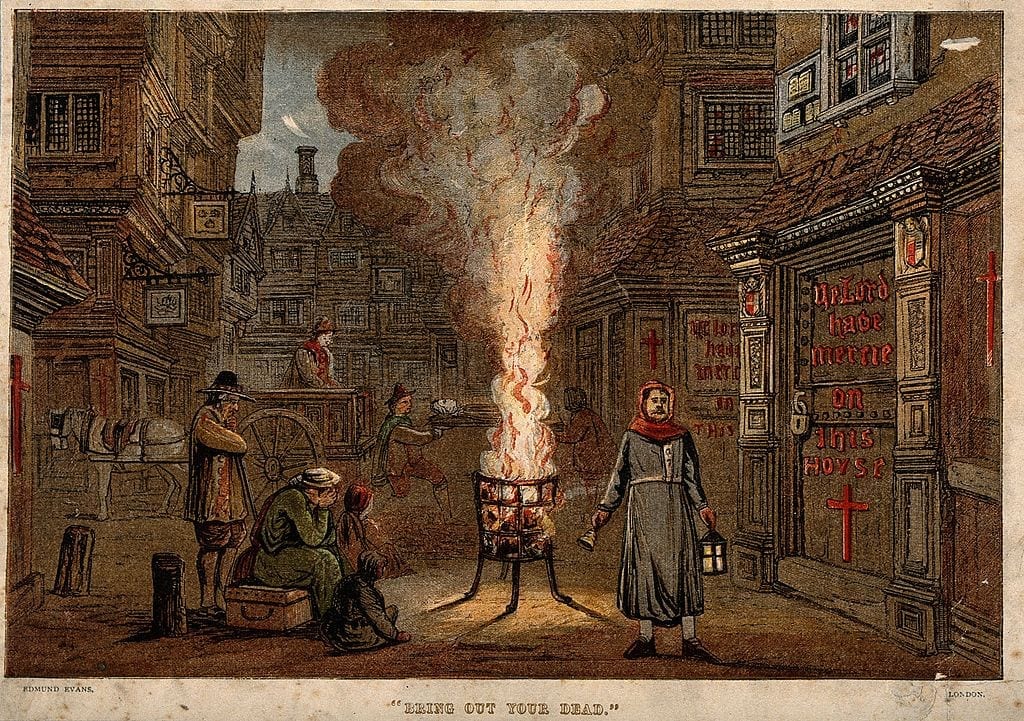Colleen Donnelly
Denver, Colorado, United States
 |
| A street during the plague in London with a death cart and mourners. Colour wood engraving by E. Evans. Wellcome Library no. 6918i. Source |
During the fourteenth century waves of the bubonic plague washed across Europe. Doomsday books of the age described an apocalypse that wiped out one-quarter to one-third of the population. Today, we are far better at tracking both the numbers of people impacted and the spread of disease, depending on the transparency and cooperation of countries. Then as today, people feared touching both the living and the dead, and today the chant “ring around the rosie, pocket full of posies, ashes, ashes, we all fall down,” which originated in the years of the plague, is more than just a nursery rhyme, but rather a reminder that history does not repeat but rhymes.1
Like COVID-19, the plague was believed to have started in Asia. It traveled not by plane or automobile but by stowing away in the fur of rats in the lower decks and cargo bins of ships making their way along the Silk Road to the Mediterranean.2 Thus carried by rats, bubonic plague was transferred to humans through the bite of infected fleas jumping from one host to another. Bubonic plague readily mutated into its far more contagious pneumonic relative, and it was this pneumonic plague that was responsible for the massive deaths that occurred in Europe. Like COVID-19, pneumonic plague was transferred from person-to-person by coughing, sneezing, and aerosolized particles, and likewise was highly contagious.3
Clearly no one in the Middle Ages knew that bacteria and viruses caused diseases; illness and epidemics were often seen as God’s punishment and vengeance for man’s transgressions. When Christians saw Jewish communities faring better and having lower mortality rates, they scapegoated the Jewish people much as people blame those of Asian descent today. Though they did not understand their efficacy at the time, the good sanitary practices of the Jewish people based on Mosaic Law, from their handling of food to their treatment of human waste, somewhat helped deter the plague ravishing their communities.4
Similarly, the best defenses against COVID-19 are good hygienic practices—hand washing, face masks, and social distancing. As in the current pandemic, the plague spread more rapidly through urban populations because of the greater density and close proximity of the people. In both cases, the poor and disadvantaged people suffer more because they live more closely packed together and are more likely to suffer from comorbid conditions as well as poorer nutrition, sanitation, and working conditions. Just as the storytellers of Boccaccio’s Decameron fled the cities to escape the plague and took it with them into the rural areas and new regions, so COVID-19 spread from New York City and other urban centers to the interior—even faster than the plague, given the mobility of the modern population. COVID-19 has spread through the heartland, through meatpacking and food processing centers, through nursing homes and prisons, and across the entirety of the United States just as it did in Europe.
It is ironic that while we know more scientifically about the nature of disease today, the cultural peals still resound. As people in the Middle Ages clung to the belief that changing their behavior and restraining their carnal appetites and mortal desires would appease God and put them back in His good graces ending their misery, so today some church leaders defy centuries of advances in science, assuring their congregations that it is safe to assemble because God will keep safe his chosen, whoever they must be.
The Middle Ages had its charlatans who touted false cures and prophylactics—sacred relics that would protect, self-flagellation, herbs, and blood-letting.5 Knowing nothing about the nature of the disease, they readily took advantage of public ignorance and hysteria for profit. Their contemporary successors tout heat, hydroxychloroquine, and oleandrin, encouraging distrust and skepticism of the very science that brought cures for smallpox and polio. This is also inflamed by the twenty-four-hour news cycle. Science requires conscientious validation and verification, but when public angst is high and there is a strong desire for immediate answers, such behavior, such as when experts continually revise their advice based on newly emerging best evidence, fuels distrust rather than appreciation for the care that is being taken to protect public health.
In the twenty-first century, we have empirical research that has helped to cure or at least mitigate epidemics, from influenza and SARS to Ebola and HIV. But in dealing with these health challenges, one may wonder how much humans have changed over the centuries in how we respond to epidemics that threaten our existence. As the science to cope with the current pandemic evolves, it may serve us well to pay more attention to the social and psychological dynamics that are also at work. That means engaging fear and apprehension more strategically and paying attention to those deeply engrained negative and emotional responses that hinder rather than help us deal with the rhymes of history that we face during the current epidemic.
References
- Attributed to Mark Twain.
- See, among others: Nicholas Wade, (31 October 2010). “Europe’s Plagues Came From China, Study Finds”. The New York Times.
- For information of plague type see: World Health Organization. “Plague.” https://www.who.int/news-room/fact-sheets/detail/plague
- Pasachoff, Naomi E.; Littman, Robert J. (2005). A Concise History of the Jewish People. Lanham: Rowman & Littlefield. p. 154. Joseph P Byrne (2012). Encyclopedia of the Black Death Volume 1. p. 15 “Anti-Semitism and Anti-Jewish Violence before the Black Death.
- See for example, Mark, Joshua J. “Medieval Cures for the Black Death.” Ancient History Encyclopedia. 15 Apr 2020. Web. 26 Aug 2020. https://www.ancient.eu/article/1540/medieval-cures-for-the-black-death/
COLLEEN DONNELLY specializes in medieval and twentieth-century literature, language, and linguistics. Returning to her earlier science training, she is currently conducting research in medical humanities on issues of mental illness, disability, and narrative voice.

Leave a Reply